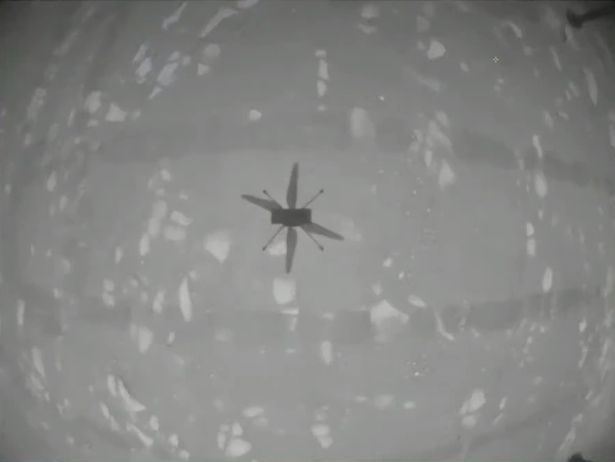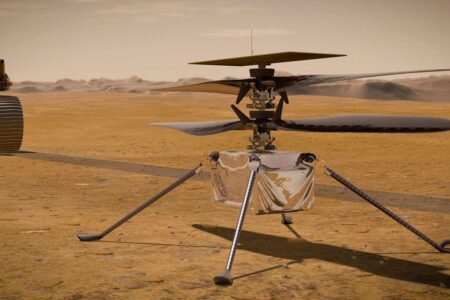NASA’s Ingenuity Mars helicopter has completed the first-ever powered, controlled flight on another planet, the space agency has announced.
The miniature solar-powered robot successfully took flight on the red planet on Monday morning, hovering around 10 feet or three metres in the air.
It was airborne for less than a minute before descending and touching back down on the Martian surface.
Pictures showed a shadow of the twin-rotor Ingenuity hovering above the planet’s surface, and a video showed it grounded on the surface.
The message “Ingenuity has performed its first flight – the first flight of a powered aircraft on another planet” was met by cheers and applause at mission control.

(Image: NASA)
MiMi Aung, Ingenuity Mars Helicopter project manager at Nasa’s Jet Propulsion Laboratory (JPL), said: “We can now say that human beings have flown a rotorcraft on another planet.
“We’ve been talking for so long about our Wright Brothers moment on Mars, and here it is.”
NASA tweeted: “It happened. Today our #MarsHelicopter proved that powered, controlled flight from the surface of another planet is possible. It takes a little ingenuity, perseverance, and spirit to make that opportunity a reality.”
British astronaut Tim Peake was among those who congratulated the team at NASA.

(Image: via REUTERS)
He tweeted: “Huge congratulations to the whole team who have just made history. The #MarsHelicoper has flown today from the newly named ‘Wright Brothers Field’ on #Mars.”
Data from the first flight returned to Earth a few hours after the autonomous test of the robot, which was carried to Mars by the Perseverance rover, landing on February 18 this year.
The Perseverance Twitter account shared a video of the aircraft on the surface of the planet with its rotors spinning.
It said: “You wouldn’t believe what I just saw. More images and video to come…”
Video Unavailable
The 1.8kg helicopter, which flew for 40 seconds, was carried to the red planet by the space agency’s Perseverance rover. It weighs a mere 0.68kg on Mars because of the red planet’s lower gravity.
It is armed with two rotors that spin in opposite directions to lift the drone off the ground.
As well as the lower gravity, the helicopter faces the challenge of flying in the Martian atmosphere, which is about 100 times thinner than Earth’s.
The space agency previously called the flight a “Wright brothers moment” and even attached a stamp-sized piece of the aviation pioneers’ 1903 plane wing to Ingenuity.
(Image: NASA/JPL-CALTECH/AFP via Getty I)
(Image: NASA)
It said a successful flight could pave the way for new modes of exploration on Mars and other destinations in the solar system, such as Venus and Saturn’s moon Titan.
Ingenuity was scheduled to fly three metres above a Martian basin called Jezero Crater and hover there for 30 seconds, before rotating and coming back down.
Officials said data returned from Mars showed that this had in fact occurred.
But there were fears about the pre-programmed flight potentially failing due to the challenging conditions of Mars.
Ingenuity used its cameras to record pictures and video of the planet’s surface.
(Image: NASA/JPL-CALTECH/AFP via Getty I)
(Image: Getty Images)
Perseverance fed data on the flight back to Earth, but there was a three-hour time lag between the planets, which are 173 million miles apart.
As it is a technology demonstration, the helicopter does not have any scientific instruments on board.
Ingenuity will attempt additional experimental flights, which will involve travelling further distances and increasing altitudes.
All together the helicopter will aim for up to five test flights within a 30 Martian-day (31 Earth-day) demonstration window.
(Image: NASA/AFP via Getty Images)
(Image: NASA/AFP via Getty Images)
It is designed to be mostly autonomous, so Nasa will not be able to control the helicopter remotely.
This is because of the distance between Earth and Mars – it takes more than 11 minutes to get a radio signal back to Earth.
The space agency said it will not be able to look at engineering data or images from each flight until well after the flight takes place.
The 1.5-foot-tall copter arrived on Mars inside the Perseverance rover on February 18.
The first flight had been scheduled for earlier this month but was delayed after a technical issue during a test of the rotors.
The Mirror’s newsletter brings you the latest news, exciting showbiz and TV stories, sport updates and essential political information.
The newsletter is emailed out first thing every morning, at 12noon and every evening.
Never miss a moment by signing up to our newsletter here.
NASA explained: “During a high-speed spin test of the rotors… the command sequence controlling the test ended early due to a ‘watchdog timer expiration’.
“This occurred as it was trying to transition the flight computer from ‘Pre-Flight’ to ‘Flight’ mode.
“The helicopter is safe and healthy and communicated its full telemetry set to Earth.
“The watchdog timer oversees the command sequence and alerts the system to any potential issues.
“It helps the system stay safe by not proceeding if an issue is observed and worked as planned.”

